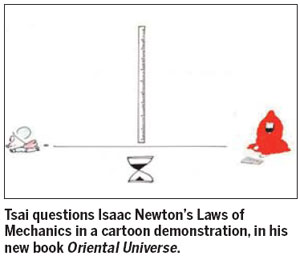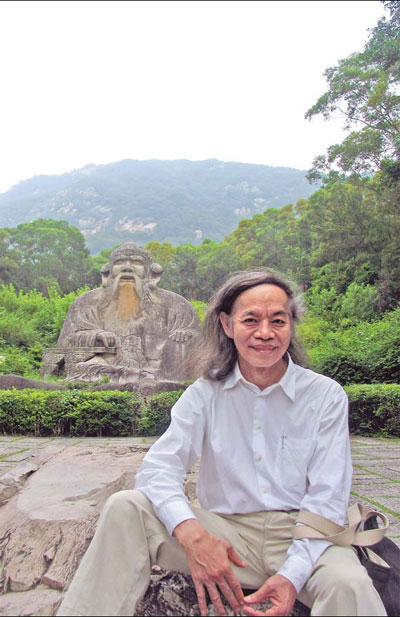Life and Leisure
Time for a change
By Zhang Zixuan (China Daily)
Updated: 2010-09-17 07:49
 |
Large Medium Small |
|
Tsai Chih-chung sits in front of the statue of Laozi on Qingyuan Mountain, Quanzhou, Fujian province. Provided to China Daily |
Taiwan cartoonist, Tsai Chih-chung, uses art to challenge the orthodoxy of Western science. Zhang Zixuan reports
Tsai Chih-chung, one of the most successful Taiwan comic artists, returns to the public eye after 10-year's absence, only this time as a physicist. "I can use 101 methods to prove that Albert Einstein's theory of relativity is wrong," says Tsai, who dropped out of school and became a professional cartoonist at 15. Tsai, who always speaks in a gentle voice, claims he uses traditional Chinese philosophy to explain physics, and that he has found a "Time Formula", which can be applied to celestial bodies of any mass and gravity.
As a comic artist, Tsai is well-known for his understanding of traditional Chinese philosophy and literature and his use of humorous cartoon figures to present Chinese ancient schools of thought such as Confucianism, Taoism and Zen Buddhism in a vivid and popular way.
He has produced more than 100 books on Oriental thought, such as Confucius Speaks and Zen Stories, and around 40 million volumes have been sold in 45 countries.
The 62-year-old could have kept on enjoying the rewards of fame as a great comic master, but his restless curiosity has led him in many different directions and at the age of 50, he fell in love with physics.
"I have 10 specialties and drawing cartoons is just one of them," Tsai says.
On Sept 3, 1998, Tsai stopped all his routine work and began to immerse himself in the world of physics. His research, which he thought he would be able to finish within three years, turned out to be a decade-long project.
During his 10-year seclusion, the newcomer to science got up to work at 1 am every night, read numerous academic works on physics and mathematics and explored the workings of the universe, using Oriental thought.
By 2008, Tsai's studies had resulted in 160,000 drawings and 14 million words. Tsai decided he wanted to publish 200 books, and with the aid of The Commercial Press he aims to publish them all in five years.
"For the past few decades I've been presenting others' thoughts. Now I think it's time to draw my own ideas," he says.

"I'd rather consider Tsai as an ideologist," comments Yu Dianli, general manager of The Commercial Press. "Cartoons are just a channel for him to express his understanding of Oriental thought, science and life."
Tsai describes himself as a desperate idealist who is fascinated by everything unknown.
"Whatever the form: religion, science, Chinese, English, etc, truth is truth, unless it's not," he says.
He decided to figure everything out on his own, ever since primary school when one of his teachers started getting evasive when Tsai asked him 23 questions he couldn't answer.
"Even things written down and published are not necessarily the answer," Tsai says.
As an amateur physicist who dares to challenge the classic theories of Isaac Newton and Einstein, Tsai predicts his latest works will draw severe criticism, but he remains undaunted.
"Even if my theory isn't proved during my lifetime, I will always have faith in it," he says.
